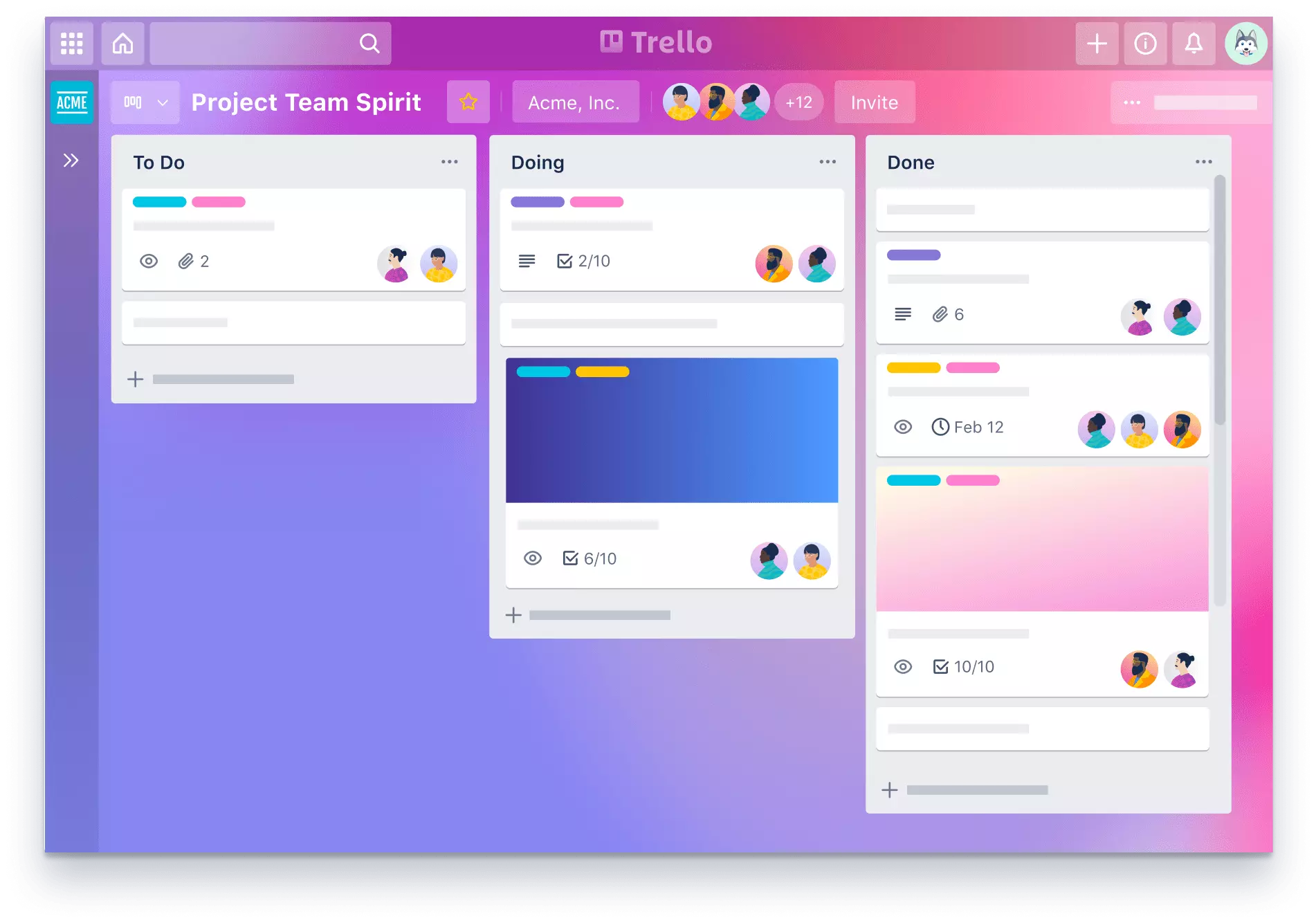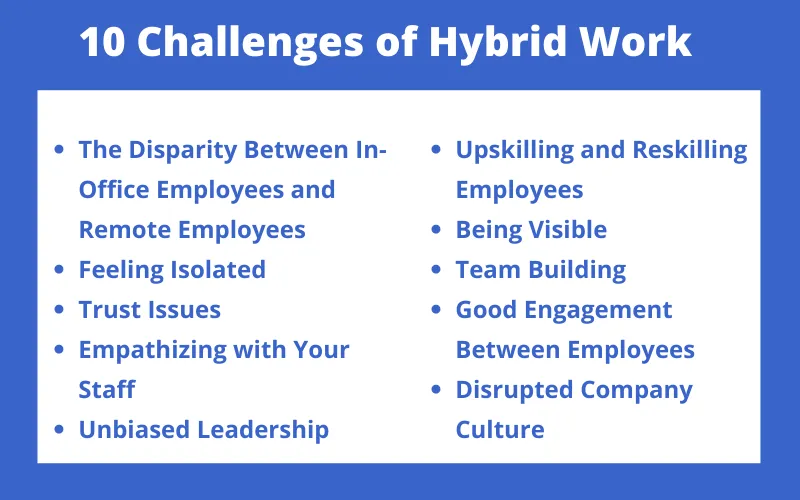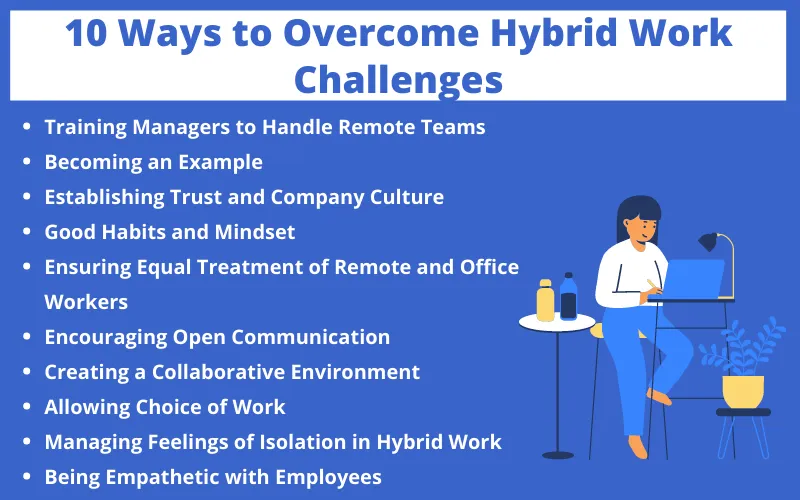How to Overcome the Challenges of Hybrid Work
How to Overcome the Challenges of Hybrid Work

Going to the office for work is a traditional way of working. Providing flexibility, offices have encouraged remote workers: to work from a remote workspace.
Remote working has numerous benefits for organizations, including reducing their carbon footprint and increased productivity.
The benefits are also recognized by employees who have reduced stress and a better work-life balance. Many employees prefer remote working.
Now, what is a hybrid working module? A hybrid work environment refers to the category where employees can work remotely or come to the office when they want.
For example: When you have an event at home, you can make time for work, sit in your bed and work from home for that day. And the following day, you can go to the office.
Many organizations will likely adopt the hybrid working model to take advantage of in-office and remote working.
But, it is not without challenges that hybrid workplaces exist. If these challenges are not addressed, organizations will have to deal with two-tiered challenges.
What are the best ways to ensure the success of your hybrid model? In this article, we discuss the 10 challenges of hybrid work and mitigate them. Please have a read:
Make your projects a success, your team a champion
Better Employee Analytics

Make your projects a success, your team a champion
Better Employee Analytics
What is Hybrid Work?
Hybrid work is an adjustable working model where people can work partly in a physical office and partly at home.
As reported by Global Workplace Analytics, if employees work in a hybrid workplace, they would be happier 83%, improve their work/life balance by 81%, and recommend their company to a friend more often.
Hybrid work comes in many forms. Several companies allow their employees to work part-time remotely and part-time on-site. Workers at other companies may work full-time remotely or full-time on-site. Others may allow a combination of the two.
The benefits of hybrid working include improved mental health, less work burnout, and better working relationships.
10 Challenges of Hybrid Work

The Disparity Between In-Office Employees and Remote Employees
Hybrid working can lead to a mismatch between employees in the office and those who work remotely if implemented haphazardly.
You must ensure both autonomy and collaboration are represented in a hybrid working arrangement since hybrid work balances these two.
Feeling Isolated
Dealing with a lack of social interaction remains one of the greatest challenges for those working in hybrid environments.
Employees who work from remote workplaces for extended periods are more likely to lose the connections and camaraderie of day-to-day office collaboration.
Trust Issues
Any hybrid work model can only succeed if there is trust between partners. Nevertheless, it is extremely difficult to foster camaraderie through remote work, especially for those new to the team.
Delegating tasks individually can make feedback less frequent, as well. It may also appear unauthentic for workers who are used to face-to-face contact and leaders who downplay their supervision methods.
Empathizing With Your Staff
An effective leader needs to have the qualities of time and empathy. Even though it seems straightforward, being an empathic leader requires practice.
Many employees feel that leaders are still not demonstrating enough empathy.
Empathic leaders are more likely to feel comfortable being vulnerable and acknowledge numerous opportunities for improvement.
A hybrid working model does not allow for the fake display of empathy. To cope with the present situation, organizations need to adopt a broad range of solutions.
Unbiased Leadership
When collaborating with hybrid teams, it is essential to adopt a sensible approach. In the event of this pandemic, some of your employees might not have access to reliable internet or may not have any devices other than their mobile phones.
Upskilling and Reskilling Employees
To adapt to changing industry needs, organizations that choose a hybrid working model should improve their current skill sets to accommodate their office structure and meet consumers’ rapidly evolving needs.
Skilling employees with up-to-date technologies and improving their working skills is a challenge.
Being Visible
Leadership begins with visibility. It was easy when everyone shared a workspace, but now leadership teams need to be accessible to both office workers and remote workers.
Remote workers will inevitably feel cut off even though they are highly productive. Employees in the office might perceive, from their perspective, that they receive more recognition and have better projects.
People expect managers to treat people equally to avoid claims of injustice, so they will want transparency, honesty, and fairness in how commercial decisions are made.
Maintaining visibility is as easy as conducting regular check-ins, where workers can ask questions while communication lines remain open.
Team Building
Colleagues who might have once been close can feel a sense of distance when they spend less time together at work.
People can stay united even when they are not physically present by creating new systems and ways of working. When they stay connected, they will make a strong team bond.
Video conferencing is one way to accomplish team building. Keeping everyone informed and informed about day-to-day responsibilities aims for better communication and coordination.
Good Engagement Between Employees
Keeping track of team morale and employee engagement in a hybrid world will be challenging. Employee satisfaction needs to be measured to maintain good communication.
Many people who work from home feel isolated, affecting their loyalty and retention. In light of this, it’s important to engage your employees through regular feedback surveys and ask for their input.
Those who feel isolated can be trained to support these individuals and effectively affect employee engagement.
As well as regular appraisals and training, setting goals and training ensures staff members stay engaged and motivated.
Disrupted Company Culture
With the advent of remote working, certain routines, rituals, and jokes that used to be a feature of organizations primarily based in offices have been rendered obsolete.
When a culture shifts from a monoculture to a hybrid model, it reviews what aspects need to be preserved and unretainable.
The Ultimate Workforce Analytics & Productivity Software – Try Now!
Error: Contact form not found.
You can Email us anytime. For more details, review our Privacy Policy.
10 Ways to Overcome Hybrid Work Challenges

Training Managers to Handle Remote Teams
There has been an increase in trust in the workforce due to the pandemic. Managers had little choice since employees often worked from home and were generally out of sight.
The challenge with hybrid working is maintaining it long-term since performance can’t easily be monitored, and it’s hard to tell whether people feel engaged and included.
Thus, management training can be helpful in this regard. Monitoring performance, engaging the team, and addressing employee wellbeing are important skills that can make or break employee motivation and satisfaction.
Becoming an Example
Protection of employee wellbeing is of the utmost importance for remote and hybrid working.
The chances of people setting boundaries, taking breaks, and stopping work at a predetermined time are diminished when they work remotely.
It is extremely dangerous for leaders to ignore burnout, stress, or poor mental health as the transition towards hybrid working gathers speed.
Workers should take breaks and work within clearly defined hours, regardless of whether they are at home or work.
Setting clear parameters and leading by example is the most effective means of achieving this goal.
Leaders who take regular breaks and switch off at a certain time are more likely to inspire their employees to do the same.
Establishing Trust and Company Culture
Effective Leadership skills such as empathy, trust, and culture establishment have always played a major role. We have now become more aware of the significance of these traits as we embrace the new ways of working.
Any leader must listen, observe, and respond to all situations to be successful.
To create a productive and creative hybrid workforce, employers must listen to employees and adapt to their needs agilely.
Good Habits and Mindset
Getting rid of many habits will be difficult if the entire company’s employees have been heavily office-centric in the past.
There may be discussions in the cafeteria about remote work teams, focusing on results rather than clocking in and out to determine whether or not a full, productive day has been had or skepticism about apps and software that automate life routines.
Promoting good habits and a positive mindset is important to address issues due to lack of communication and diminished output.
Ensuring Equal Treatment of Remote and Office Workers
Passive facetime results in less feedback, fewer promotions, and fewer raises for remote workers than those in the office. In essence, remote workers are not seen, so they suffer.
Despite popular belief, those who work outside of office hours are more committed to their work, even though they may work just as long.
Managers must develop good strategies, tools, and structures to ensure equality between remote and in-person performance management.
The hybrid model will erode as employees recognize the link between being at work and their professional success without equality.
Encouraging Open Communication
Employees in the office and those working remotely benefit from transparent communication practices.
Communication issues negatively affect employee morale. Due to poor communication, remote employees often miss out on important information.
Organizations must have procedures to share the results of informal, in-person communication with other stakeholders as appropriate.
It’s a good idea to document or write all formal communications to make sure that they reach all employees.
Communication is never disruptive when done in the right channel and structure.
To prevent silos between teams and between in-office and remote employees, employers should encourage their employees to communicate as much as possible.
Must read: Ways to enhance team communication at the workplace.
Creating a Collaborative Environment
It is difficult for remote employees to be part of the workplace culture and connect spontaneously with their coworkers.
Team leaders should schedule time for the whole group to meet in the office to facilitate team collaboration. In this way, others can offer support and guidance to their colleagues.
In addition to formal creative sessions, managers should also set up informal ones. It is important for teams to have a free flow of ideas and to inspire each other with their solutions.
Must read: What are the best ways to adopt new work cultures?
Allowing Choice of Work
Providing a collaborative, creative workspace will require updating the workplace itself. Since employees will come to the office for specific reasons, the experience should be better than before.
It’s the priority for workplace and facilities managers to create an engaging and welcoming workplace.
They should consider offering employees something unique and different from their home office.
Choosing where to work means employees can structure their working week around collaboration, focused work, and social events with coworkers.
As their needs change, the services and amenities needed must also evolve, offering convenience and making the most of employees’ time at work.
Managing Feelings of Isolation in Hybrid Work
Ideally, a hybrid model would succeed if employees and managers felt confident the workplace they chose would support their roles rather than hinder them.
Remote working requires a greater degree of human interaction. By overseeing the management and engagement of social and wellbeing events, community managers within workplace teams should also help manage feelings of isolation in employees and bridge the gap.
Managers must know they can support all their team members, regardless of where they are located, so employees feel confident they can achieve a balance between home and the corporate office.
Being Empathetic with Employees
To be empathetic, you have to step outside your comfort zone and connect with others through their shared experiences. A hybrid work arrangement requires constant communication.
As a leader, it’s your responsibility to set the tone for an empathetic work environment and ensure every team member acts empathetically.
Keeping the lines of communication open for addressing similar issues and any mental health concerns that may arise during the implementation of the hybrid model is important. Problem-solving virtual forums can help you achieve this.
💡 The following articles can give you more details on Remote Work. All our blogs has detailed information on the topic such as:
Conclusion
Establishing a hybrid work model can hinder businesses if not done correctly and thoughtfully.
However, good strategies, skills, and tools can help resolve the issues. You will yield a great company outcome when you can overcome the challenges of adapting a hybrid work model.
The Ultimate Workforce Analytics & Productivity Software – Try Now!
Error: Contact form not found.
You can Email us anytime. For more details, review our Privacy Policy.
Make your projects a success, your team a champion
Better Employee Analytics

Make your projects a success, your team a champion
Better Employee Analytics




 in Melbourne
in Melbourne 
 Employee Screen Monitoring Software
Employee Screen Monitoring Software App and Website Monitoring Software
App and Website Monitoring Software Time and Attendance Software
Time and Attendance Software Finance
Finance Banking
Banking Healthcare
Healthcare Lawyers
Lawyers Retail & ecommerce
Retail & ecommerce Knowledge base
Knowledge base Blogs
Blogs Installation Guide
Installation Guide FAQs
FAQs About
About Media Kit
Media Kit Contact us
Contact us